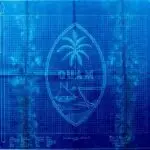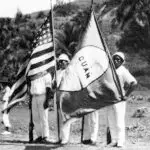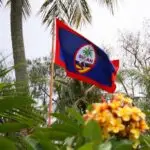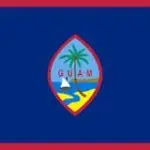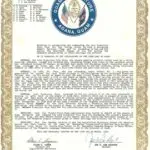Guam Seal and Flag
Table of Contents
Share This
Dates back to 1917
The Guam seal is an oval outlined in red that tapers and comes to two pointed ends. This shape is in reference to the ancient Chamorro/CHamoru slingstone, a weapon skillfully wielded by the ancient Chamorros. Included in the seal are the Hagåtña River which empties into the sea; the sandy mouth of the river and surrounding beach graced by a lone coconut palm, an important means of sustenance to the Chamorro people; and a flying proa, the chief means of transportation for early Chamorros. The distant cliff along the horizon references Two Lover’s Point, or Puntan Dos Amantes, named for the legend of a forbidden romance between two lovers who rather than be separated, tied their hair together and leapt off this point into the sea.
These specific aspects of Chamorro culture symbolize the courage, perseverance and prowess of the Chamorro people. “Guam” is printed across the middle of the seal in bold red letters.
The colors of the Guam seal are as follows: the sky is light blue, the ocean is medium blue, the palm tree is green and brown, the beach is yellow, the cliff is green, the canoe is brown with a white sail and the lettering is red.
Guam seal is the centerpiece of the flag
The seal is the centerpiece of the Guam flag. The flag itself is a deep blue trimmed on all sides by a red border.
Today, Guam flies this flag together with the flag of the United States of America. Until 1917, however, Guam did not have its own flag, rather the flag of Spain was raised until 1898 and later the US flag was raised over the island.
Seal and flag's design history
The original inspiration for the design of the Guam seal is disputed. The three most likely inspirations, however, are the works of local artist Francisco Feja, a photograph from former Governor Robert E. Coontz’s collection from 1912, and sketches by Helen Paul, wife of Commander Carrol E. Paul.
The Guam Legislature, however, issued a Legislative Resolution in 1992 recognizing Francisco Feja for designing the Guam seal. Resolution 308, introduced by Senators Madeleine Z. Bordallo, Carl TC Gutierrez, and Speaker Joe T. San Agustin, says that in 1910 Feja was a student at the Leary School in Hagåtña when the school’s principal, Francisco Taitano, gave him the opportunity to attend Jose Rizal College in the Philippines. When he returned to Guam he began to draw the many island images that came to his mind:
One sight he saw as he sat under a tree at the beach in Agaña, was a boat sailing across the water, with the sun shining upon the scene, which image later became the design of the Guam seal and thus the image used for the beautiful Guam flag. Naval Governor Roy Smith in 1917 accepted the seal and flag for the Naval government which used both until they were formally adopted in 1930.
Feja gave the flag to the wife of Naval Governor Willis W. Bradley as a reminder of the Chamorro people and the island of Guam. Bradley approved the flag, which would thenceforth be flown over Guam and which Guam would use to represent the island all over the world.
Thus, Francisco Feja, although he did not realize it at the time, succeeded in helping to give back to the people of Guam their identity which was in danger of being lost during the many years of domination by outside cultures, and appropriately if belatedly, his important contributions to the growth and development of the island’s renascent cultural pride were recognized in 1978 when he was made a member of the ‘Highest Fraternity of Wisdom of the Chamorro Chief Kepuha’ by the late Governor Ricardo J. Bordallo, who honored him for his dedication and service to the people of Guam.’
The resolution recognizes and commends Feja for designing Guam’s flag.
However, according to the papers of Anita M. Elvidge, wife of Governor Ford Q. Elvidge – appointed civilian governor of Guam from 1953 to 1956, due to popular demand for an island flag in 1917 a design by Helen Paul was approved and recorded in Washington DC by Guam’s Naval Governor Roy C. Smith.
Helen Paul made many sketches of Guam including one which depicted a lone coconut palm on a beach at the old mouth of the Hagåtña River backed by the sea, a distant cliff and a flying proa. According to the papers of Anita M. Elvidge:
… that sketch was copied by students in the home economics class of Mrs. Lillian Nagal, wife of Marine Sergeant Nagal, and was made into the first island flag of Guam.
According to the July 1917 edition of the Guam News Letter (a naval government monthly publication):
The flag made its first appearance on July 6, 1917 when it was formally received, together with the national colors, by the Guam Cadets at parade on behalf of the people of Guam.
Flag first raised in 1918
On 4 July 1918 this flag was raised at ceremonies for a fair held in Hagåtña.
In a July 1930 edition of the Guam Recorder, a monthly magazine under the direction of the Naval Government of Guam from March 1924 until the Japanese occupation, an order signed by Governor of Guam Willis W. Bradley, Jr. was printed and reads:
Order effective this date, the official seal of the Naval Government of Guam will be shown on the plan of the Guam flag approved July 4, 1917, by Governor Roy C. Smith, and now filed in the office of the Auditor-Registrar…
Another order signed by Guam Governor Willis W. Bradley, Jr. printed in Guam Recorder, No. 71, 12 May 1931 reads:
1. The flag shown on the “Plan of Guam Flag,” approved 4 July 1917, by Roy C. Smith, Governor of Guam, and now on file in the Department of Records and Accounts, is hereby designated as the Island Flag of Guam.
2. The Island Flag adopted by this order consists of a dark blue field having the seal of Guam, adopted by Executive Order no. 18, of 4 April 1930, superimposed on both sides of the flag.
In 1945 and 1946, the Guam Attorney General and the National Geographic Society of Washington DC corresponded extensively regarding the color, size and manufacture of the Guam flag and seal and in July 1946 National Geographic Magazine published a color reproduction of “Seals of Our Nation, States and Territories.”
Red border added after WWII
By 1948, a red border on the flag was added. Details of the flag including references to a deep red border two inches in width are documented in Guam Congress Bill No. 12 approved by Naval Governor CA Pownall on 9 February 1948. The legislation, enacted by the House of Assembly and the House of Council of the Guam Congress, as included in Civil Regulations Chapter VI-A entitled, “Territorial Flag of Guam” Section 1 reads:
The official territorial flag of Guam shall consist of a rectangular field of marine blue seventy-eight inches long and forty inches wide, trimmed on all sides with a border of deep red two inches in width and having in its center the Guam Coat of Arms (a two-pointed oval scene twenty-four inches high and sixteen inches wide, which portrays an ancient flying proa (canoe) about to make a landing on the beach near a lone palm tree). The colors of the Guam Coat of Arms shall be as follows: yellow which represents the sand; brown, the tree trunk and canoe; gray, the distant flat-topped mountain; red, the letters GUAM emblazoned across the Coat of Arms. Any deviation from the dimensions as stated herein shall be increased or decreased proportionately.
The bill also outlines the way the flag is to be flown alongside the US flag. It states that if the territorial flag of Guam was flown on a single staff, it should be flown below the US flag. It also states that when the flag is flown with the US flag other than on a single staff, it should be displayed either below or to the left of the flag of the US. According to Section 7 of the bill, no one was required to give a Pledge of Allegiance to the territorial flag of Guam.
Guam Judge Jose C. Manibusan was delegated to have the first post-war flag of Guam made.
Records indicate that on 10 September 1950, the Guam Congress passed Public Order No. 33, “An Act to Provide an Official Seal for Guam,” designating the 1917 design as the official territorial seal. The legislation was approved by then-Governor Pownall.
While the early Guam seal was found on official documents and orders, it was also used on the doors and sides of the governor’s car and barge. For a short period, Governor Bradley also used the seal for Guam guard-mail stamps which are now rare collectors’ items.
the seal read “Great Seal of the Territory of Guam United States of America.” In 1997 it was changed to what it reads today “Great Seal of Guam Tano I Man Chamorro.” This change only applies to the seal and not the flag.
The lieutenant governor of Guam is the designated official keeper of the seal.
By Leslie Reynolds and Deniz Smith

